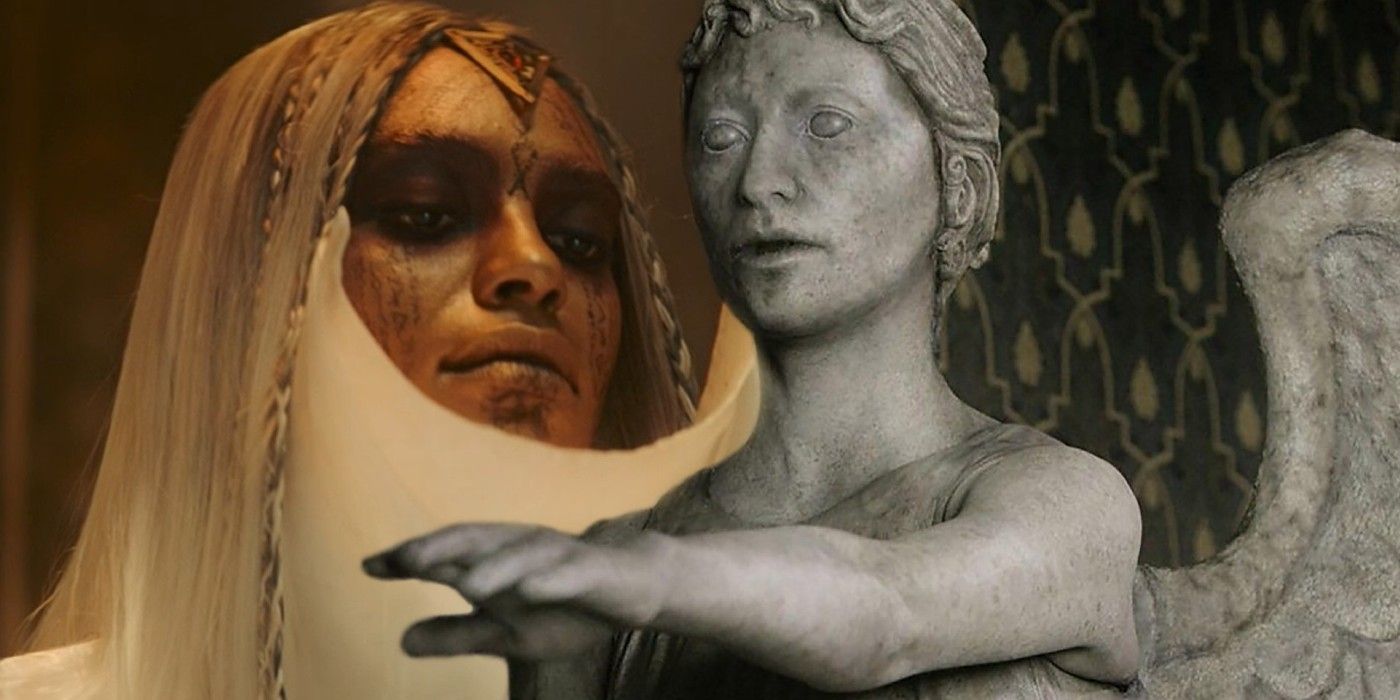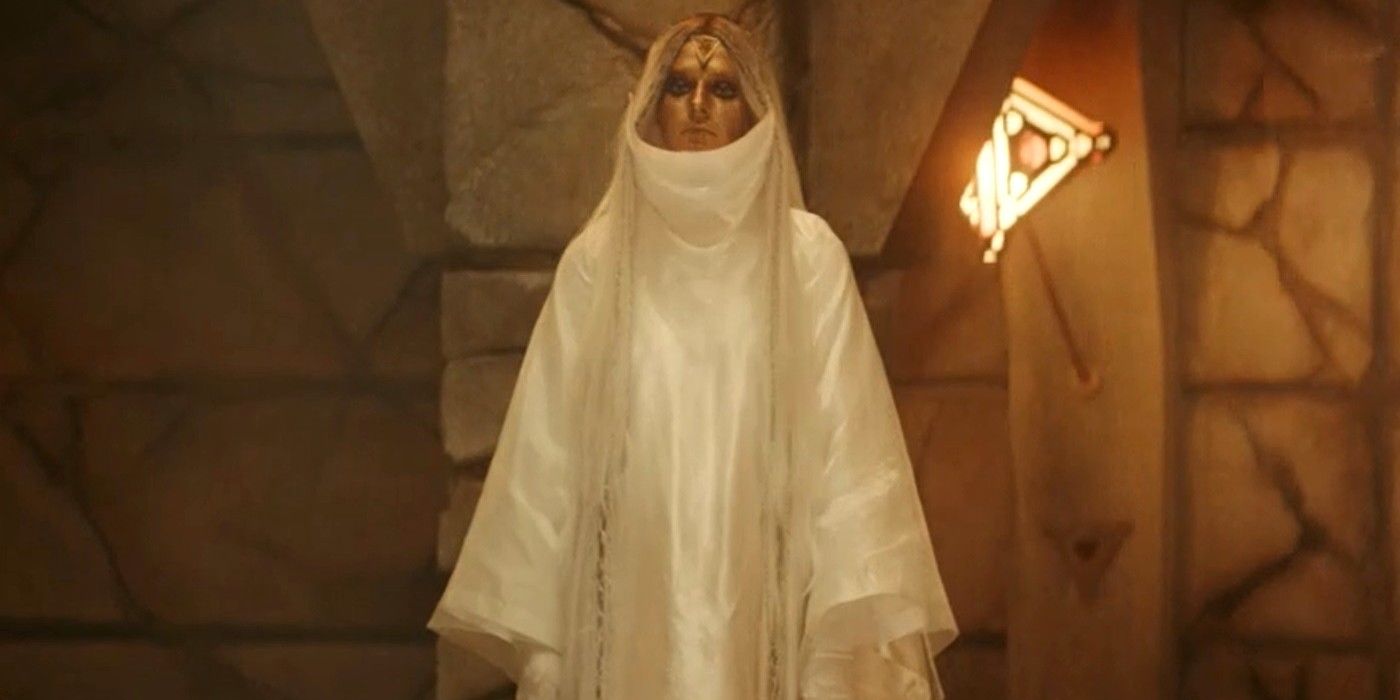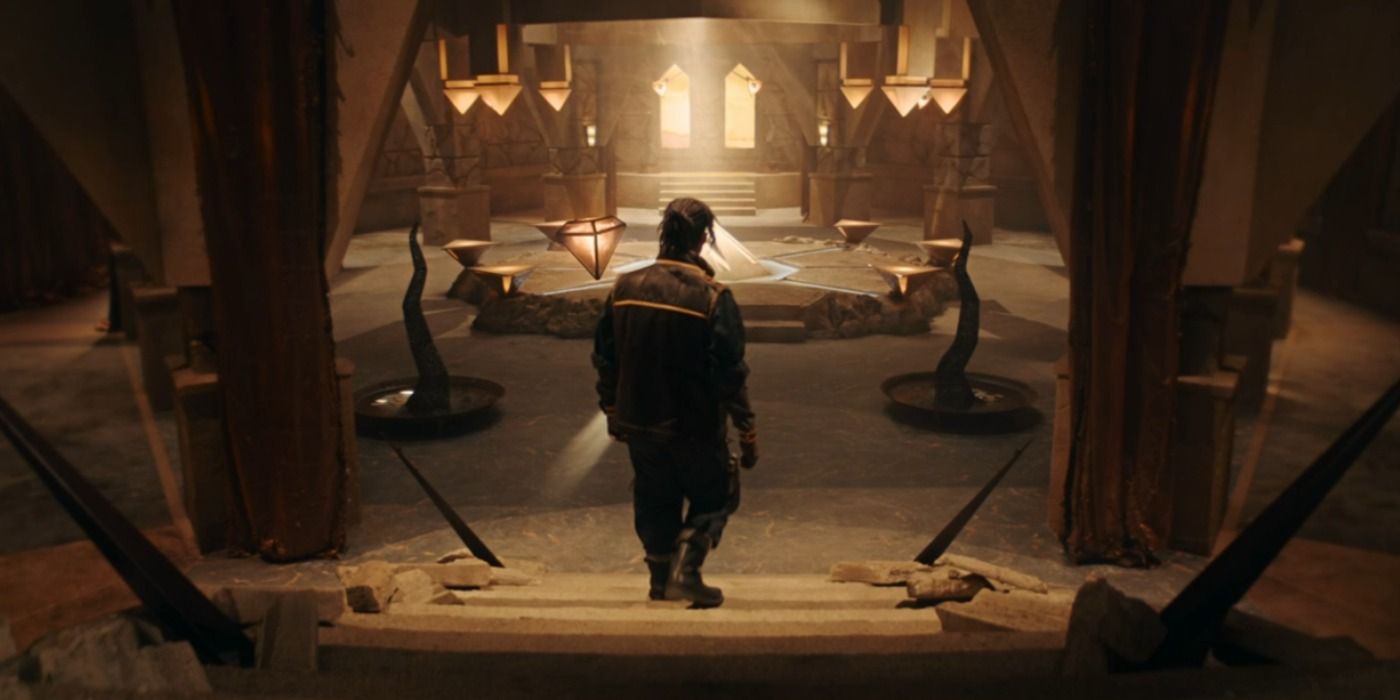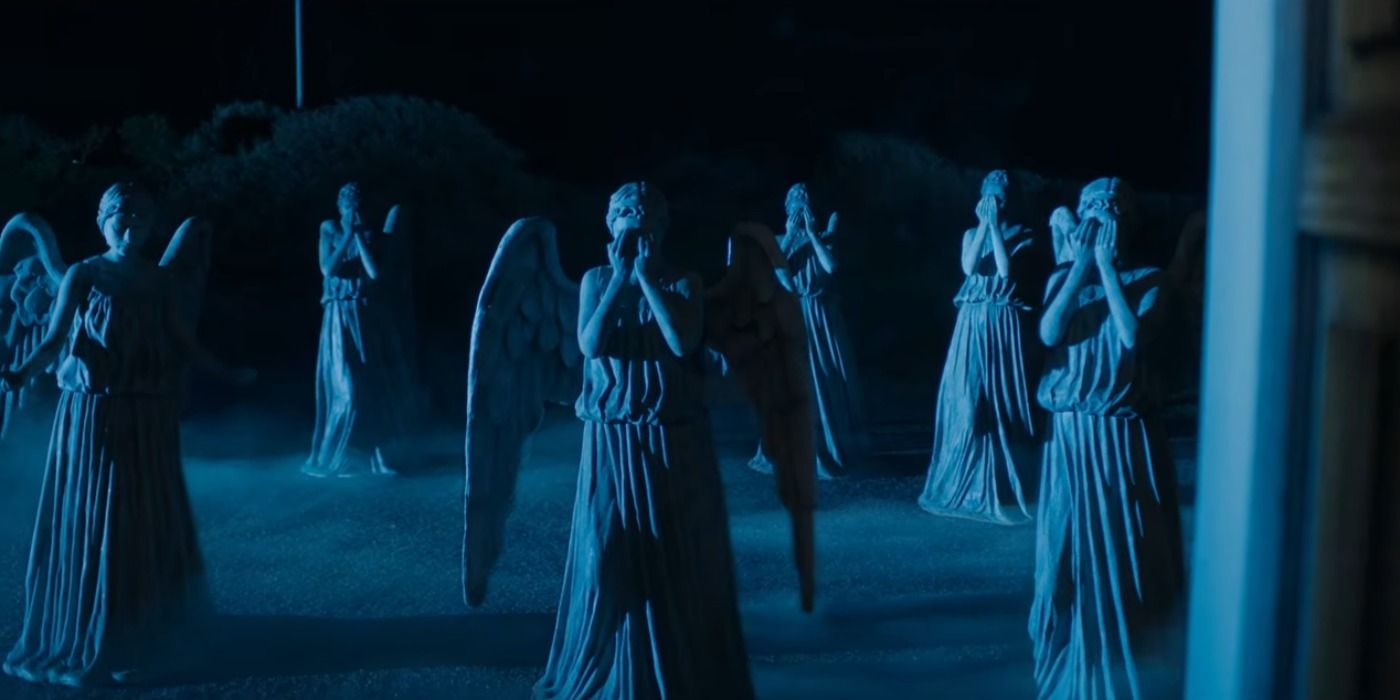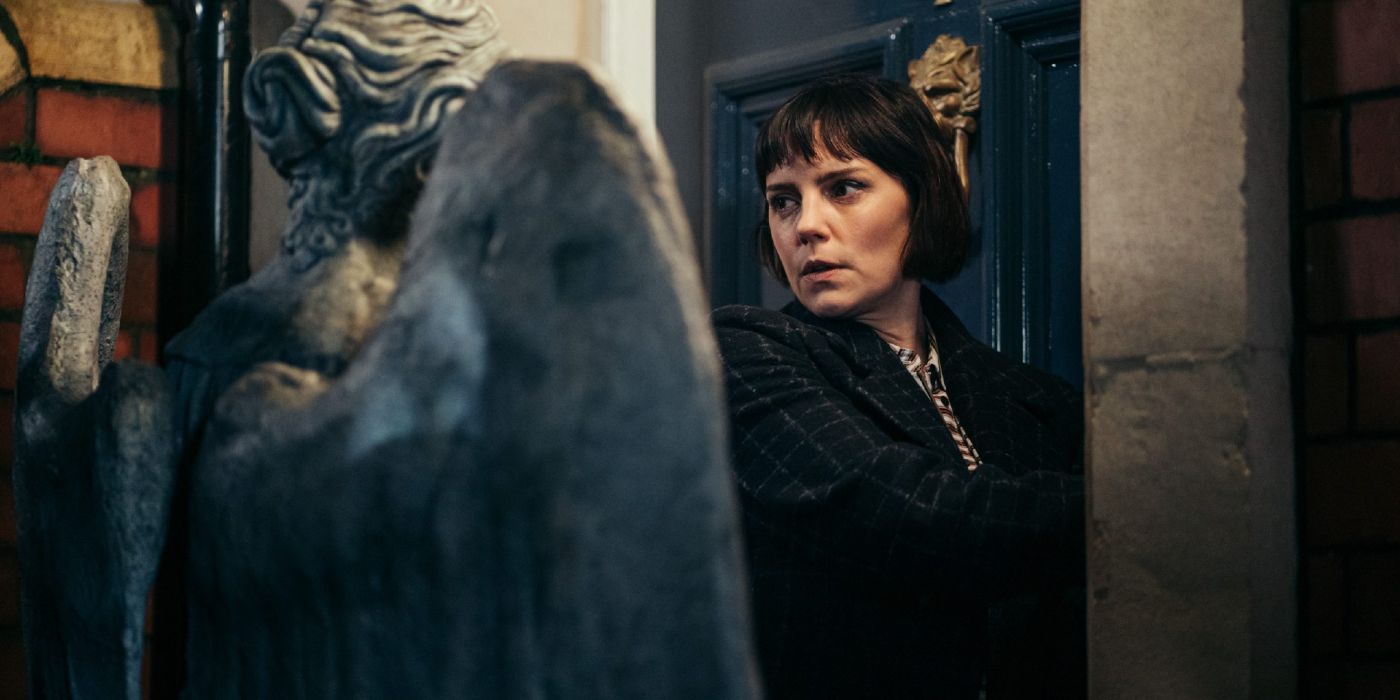Doctor Who season 13 introduces a brand new race called the Mouri, but are they really new, or is this how the Weeping Angels began? Despite a Sontaran diversion, Doctor Who: Flux is forging ahead with its central storyline. Swarm and Azure are Ravagers, enemies of The Doctor from before she looked like William Hartnell. After millennia spent guarded by The Division, Swarm is now free to wreak havoc across the galaxy, eating up entire galaxies in record-quick time using the destructive Flux phenomenon.
In "War of the Sontarans," Swarm visits the Temple of Atropos on the planet Time, and it's clear this isn't his first rodeo. Whatever happened between The Doctor and Swarm in the past, the Temple of Atropos was involved, and so were its 6 golden guardians, the Mouri. Doctor Who: Flux has revealed precious little regarding this strange new race but, already, there are suspicious parallels to Weeping Angels. Introduced by Steven Moffat in Doctor Who season 3's "Blink," the Weeping Angels are widely considered the show's strongest modern villains, but their origin remains shrouded in mystery.
Given the Mouri's obvious importance and the presence of Weeping Angels elsewhere in Doctor Who: Flux, is this how The Doctor's stone enemies originally looked? Is Time their home planet? Did The Doctor encounter them while working for The Division? Here's why Doctor Who's Mouri could be an earlier incarnation of the Weeping Angels.
Doctor Who's Mouri & Weeping Angel Similarities
Immediately, there's a visual resemblance between the Mouri and Weeping Angels - as if both species are opposite sides of the same temporal coin. Doctor Who: Flux shows the Mouri clad in flowing white robes, complimenting their golden skin. Though a Weeping Angel's appearance changes depending on the statue, the classic variety wears a very similar full-length gown, not exactly like the Mouri's, but certainly purchased from the same boutique. There's also comparison in how the Mouri and Weeping Angels stand and act (or, indeed, don't act). Though not as obviously gargoyle-esque, the Mouri stand perfectly still and straight at all times, like stone statues colored-in, and to replace the Angels' cupped hands, the six golden women have face coverings built into their costumes.
The Doctor Who Mouri-Weeping Angel crossover goes deeper still, with both species hitting the same thematic notes. Since their 2007 debut, the Weeping Angels have been one of Doctor Who's more religious antagonists. Aside from the obvious angelic connotation, the creepy statues can usually be found hanging around churches and cathedrals, where gothic sculptures typically loiter. Interestingly, the Mouri also have a quasi-religious flavor. The temple is guarded by Priest Triangles, and in Greek mythology, Atropos was one of three goddesses referred to as the "Moirai." Coincidence? We think not. The Weeping Angels could be fallen ex-Mouri, similar to angels and demons in real-world mythology.
Doctor Who: Flux's biggest link between Weeping Angels and Mouri comes when referring to the latter as "quantum-locked." This is the same term David Tennant's Tenth Doctor used to describe the Weeping Angels in "Blink." According to Ten, the villains cease to exist whenever they're observed by another living entity, only coming to life when no one's around to see them. Apparently, this ensures the Angels can't be harmed, as the quantum-locked state is near-impenetrable. By the same token, Azure claims the Mouri have been "quantum-locked" against herself and Swarm. Very few life forms in Doctor Who are capable of quantum-lock as a defense mechanism, and the way the Mouri can only be seen whenever someone activates their proximity sensor is the total opposite of the Weeping Angels disappearing when they're observed. These details add further credence to the stone villains being evil versions of the Mouri.
Close in appearance, both based around religion, and similarly quantum-locked, if the Mouri were a YouTube video, they'd be getting a copyright strike courtesy of the Weeping Angels. Remarkably, the comparison doesn't stop there...
The Mouri & Weeping Angels Are Both Consumers Of Time
Not all Doctor Who villains possess the ability to affect time, but the Weeping Angels are well accustomed to messing up history. Their preferred method of execution is sending victims to the past with one touch. The afflicted is then forced to live their remaining years in a different period, while the Weeping Angels feast upon time energy left behind by the removed person's potential, unspent life. According to the chattiest of the Priest Triangles in Doctor Who: Flux, the Mouri were installed to prevent time running wild, and now all of the universe's past, present and future runs through them. If the Weeping Angels used to be Mouri, this might explain why they feast on time energy - their former selves experienced every moment of time running through them at once; without that, the Angels are starved and require the closest equivalent.
Mandip Gill's Yaz provides more evidence that the Mouri are the original Weeping Angels. As Yaz helps Vinder mend the broken temple, she complains, "How can we fix something that can't be touched?" Maybe the reason Yaz and Vinder can't touch the Mouri is the same reason you should never high-five a Weeping Angel - any physical contact will displace that person from their natural point in time.
In "Blink," the Tenth Doctor noted how Weeping Angels are infamous for their "mercy," since victims are thrown through time rather than killed. That reluctance to murder might be a hangover from the Angels' days as the more noble Mouri.
The Mouri Could Be A Weeping Angel Origin Story
The Weeping Angels are among the most ancient of Doctor Who's baddies, hailing from the very beginning of the universe, but season 13 hints the Mouri could be even older. Upon being told he's inside the Temple of Atropos, Vinder recognizes the name and begins telling Yaz, "But it can't be..." before those pesky Priest Triangles cut him off. Vinder obviously knows what the Temple of Atropos is, but for some reason reckons this isn't some tourist attraction you can buy a ticket for. Had he not been interrupted, Vinder might've said something like "It can't be... because the temple no longer exists." When Jodie Whittaker's Thirteenth Doctor arrives, she reaches a similar conclusion, reading the location's space-time measurement as a straight-up zero. However old the Weeping Angels might be, it appears the Temple of Atropos is even older, meaning the Mouri could feasibly represent what the Angels looked like back in the day.
Obviously, something went very wrong for these beautiful golden creatures (or "pathetic temporal hags" if you're Swarm) to turn into hungry stone statues forced to munch stolen time energy. Doctor Who: Flux might explain how that transformation began. The Flux itself has already "broken" a pair of Mouri before Swarm kills a third, but what happens to a timeless creature when it dies? Rather than just ceasing to exist, maybe the broken Mouri are forced to live the sad, lonely existence of a Weeping Angel. There are many more Angels than Mouri, but it's possible only the very first statues were Mouri, and they passed the curse onto other gargoyles and sculptures across the universe.
This could mean The Doctor was actually involved in the Weeping Angels' creation. Though she might not remember it, The Doctor and Swarm battled in the Temple of Atropos long ago. And while the Priest Triangles explain the Mouri's function, they refuse to divulge who assigned them to guard the timestream. The intentional shroud of mystery over who first installed the Mouri could suggest a pre-Hartnell regeneration of The Doctor is behind them. Effectively, this would made The Doctor responsible for the Weeping Angels too.
The Weeping Angels Could Help The Doctor In Doctor Who: Flux
Knowing the Weeping Angels have a big role to play in Doctor Who: Flux adds further weight to the Mouri origin theory, but could also imply The Doctor and her angelic adversaries share a common enemy for once. If Swarm broke the Mouri and triggered their descent into lowly Weeping Angels, the remaining statues have a stone-cold axe to grind against the Ravagers. The angels would be none too pleased that Swarm has now escaped, and could extend a gray olive branch to The Doctor, offering to work together taking the Ravagers down.
Though they don't appear in episode 2, Doctor Who: Flux's premiere showed the Weeping Angels abducting Claire shortly after the enigmatic character approached The Doctor and Yaz, recognizing them from another point in time. Rather than feasting on her energy, the Weeping Angels might've sent Claire back to the beginning of time so she could aid The Doctor at the Temple of Atropos. And since the temple doesn't necessarily sit linear on the timeline, this would explain how Claire recognizes The Doctor before she gets attacked by an Angel. Though Jodie Whittaker partnering with the Weeping Angels to defeat Swarm could be Doctor Who's most unlikely alliance yet, their similarity to the Mouri hints toward a tragic origin that could unite the statues with their Time Lord nemesis.

